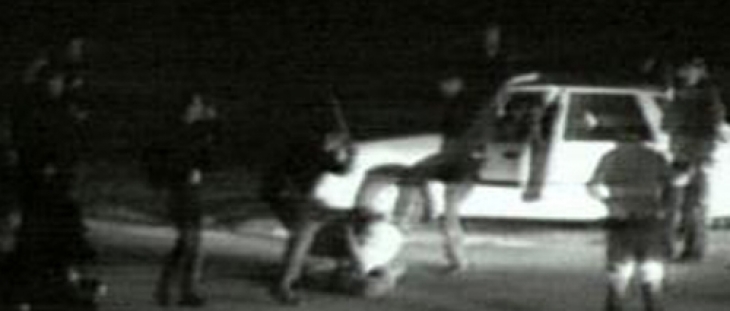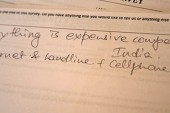
 Last month marked the 20th anniversary of one of the first modern acts of citizen journalism – and it all started out a highrise window. In March 1991, George Holliday heard police sirens and commotion out his 2nd floor bedroom window. He picked up his new consumer video camera and from his balcony, filmed the confrontation unfolding ninety feet below on a LA highway. He recorded almost 10 minutes of tape: four white LAPD police officers brutally beating Rodney King, a black man, but it was one minute of the footage that would be broadcast on TV around the world, and would spark the “Handicam Revolution.” The images, “the Rodney King Tapes,” became shocking evidence of police brutality in the public gaze of television, and they were used in the first court trial by the prosecution – as well as the defence. The images were slowed down, frame by frame, and used by the police lawyers to explain how the police officers had “followed police protocol.” When the four officers were acquitted in 1992, South Central Los Angeles erupted in what came to be known as the “LA Riots” resulting in 54 deaths, over 2,382 injuries, 7,000 fires, over 12,000 arrests, and over $1 billion of property damage. It was only in a second trial and a Federal Grand Jury that found the officers guilty in 1993. The footage, its use, impact and legacy – and the political impetus to use video technology to document human rights abuses – was the subject of a film I made almost 10 years ago with co-director Peter Wintonick, called Seeing is Believing: Handicams, Human Rights and the News. But it was only this month that I made the connection between *the HIGHRISE window* and the genesis of citizen journalism as we know it today. It is not inconsequential that new consumer-grade communications technology, which was, in the early nineties, becoming ubiquitous and affordable, would be used in one of the originating acts of citizen journalism on a balcony of the most commonly built form of the 21st century: the highrise building. And the HIGHRISE, of course, is now the frame of my multi-year, many media exploration of the human experience in vertical suburbs around the world. Today, we continue to witness the inextricable relationship between communications technology with people’s movements around the globe; in these last months in North Africa and the Arab world. I am reminded of the words of Dr. Alex Magno, a sociologist we interviewed in Manila for Seeing is Believing back in 1991: “In the last two decades or so, most of the political upheavals had some distinct link to communications technology. Iran, the Iranian Revolution, was closely linked to the audio cassette. The first EDSA uprising in the Philippines was very closely linked to the photocopying machine and so we called it the ‘Xerox Revolution’. Tiananmen, the uprising that failed, was called the ‘Fax Revolution’, because the rest of the world was better informed than the rest of the neighbourhood because of the fax machine. The [2001] January uprising here in the Philippines represents a convergence between electronic mail and text messaging. And that gave that uprising its specific characteristics.” Today we can add to Magno’s list the powerful role that Twitter, live video streaming on the net, Facebook and even dating sites have played in various stages of democratizing gestures in Iran, Tunisia, Egypt, Libya and beyond. I’m also realizing we need to understand how, just like the technology, the HIGHRISE built form (which I consider a metaphor for urban density) plays into these events. Doug Saunders, the author of Arrival City, has recently made a similar compelling argumentabout the role of urban slum density in the Egyptian uprisings. Inside these grey architectural structures that contain and shape our human, urban experience, lies the power of ingenuity, social innovation and communal force to harness and usurp our available technologies (and points-of-view) to transform them into historic, profoundly contemporary political acts. More tributes and thoughts on Rodney King 20 year later here, here and at Witness.org. Cross-posted on the NFB’s Highrise Director’s Blog.
Last month marked the 20th anniversary of one of the first modern acts of citizen journalism – and it all started out a highrise window. In March 1991, George Holliday heard police sirens and commotion out his 2nd floor bedroom window. He picked up his new consumer video camera and from his balcony, filmed the confrontation unfolding ninety feet below on a LA highway. He recorded almost 10 minutes of tape: four white LAPD police officers brutally beating Rodney King, a black man, but it was one minute of the footage that would be broadcast on TV around the world, and would spark the “Handicam Revolution.” The images, “the Rodney King Tapes,” became shocking evidence of police brutality in the public gaze of television, and they were used in the first court trial by the prosecution – as well as the defence. The images were slowed down, frame by frame, and used by the police lawyers to explain how the police officers had “followed police protocol.” When the four officers were acquitted in 1992, South Central Los Angeles erupted in what came to be known as the “LA Riots” resulting in 54 deaths, over 2,382 injuries, 7,000 fires, over 12,000 arrests, and over $1 billion of property damage. It was only in a second trial and a Federal Grand Jury that found the officers guilty in 1993. The footage, its use, impact and legacy – and the political impetus to use video technology to document human rights abuses – was the subject of a film I made almost 10 years ago with co-director Peter Wintonick, called Seeing is Believing: Handicams, Human Rights and the News. But it was only this month that I made the connection between *the HIGHRISE window* and the genesis of citizen journalism as we know it today. It is not inconsequential that new consumer-grade communications technology, which was, in the early nineties, becoming ubiquitous and affordable, would be used in one of the originating acts of citizen journalism on a balcony of the most commonly built form of the 21st century: the highrise building. And the HIGHRISE, of course, is now the frame of my multi-year, many media exploration of the human experience in vertical suburbs around the world. Today, we continue to witness the inextricable relationship between communications technology with people’s movements around the globe; in these last months in North Africa and the Arab world. I am reminded of the words of Dr. Alex Magno, a sociologist we interviewed in Manila for Seeing is Believing back in 1991: “In the last two decades or so, most of the political upheavals had some distinct link to communications technology. Iran, the Iranian Revolution, was closely linked to the audio cassette. The first EDSA uprising in the Philippines was very closely linked to the photocopying machine and so we called it the ‘Xerox Revolution’. Tiananmen, the uprising that failed, was called the ‘Fax Revolution’, because the rest of the world was better informed than the rest of the neighbourhood because of the fax machine. The [2001] January uprising here in the Philippines represents a convergence between electronic mail and text messaging. And that gave that uprising its specific characteristics.” Today we can add to Magno’s list the powerful role that Twitter, live video streaming on the net, Facebook and even dating sites have played in various stages of democratizing gestures in Iran, Tunisia, Egypt, Libya and beyond. I’m also realizing we need to understand how, just like the technology, the HIGHRISE built form (which I consider a metaphor for urban density) plays into these events. Doug Saunders, the author of Arrival City, has recently made a similar compelling argumentabout the role of urban slum density in the Egyptian uprisings. Inside these grey architectural structures that contain and shape our human, urban experience, lies the power of ingenuity, social innovation and communal force to harness and usurp our available technologies (and points-of-view) to transform them into historic, profoundly contemporary political acts. More tributes and thoughts on Rodney King 20 year later here, here and at Witness.org. Cross-posted on the NFB’s Highrise Director’s Blog.














